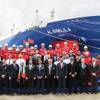Three New Arctic-class Ships on Way to Yamal LNG Terminal
Three new liquefied natural gas (LNG) tankers capable of plowing through the Arctic ice have completed sea trials in recent weeks and are due to start operations at the Yamal LNG terminal in northern Russia, Reuters shipping data shows.
Novatek's Yamal terminal has been ramping up LNG shipments faster than expected after loading its first cargo in December 2017, with two trains now running at capacity and a third being commissioned.
As part of the project, the first along northern Russian shores that are trapped by thick ice for most of the year, 15 carriers in the Arc7 class were ordered from South Korea's Daewoo Shipbuilding & Marine Engineering Co (DSME).
The Russian Arc7 classification means that a vessel is capable of traversing waters north of Russia without the help of icebreakers.
The 170,000 cubic meter Rudolf Samoylovich, operated by LNG shipper Teekay, has left DSME's Korean shipyard at Okpo and is due to arrive at Yamal's Sabetta port on Sept. 7, the shipping data shows.
Vladimir Vize, managed by Mitsui Osk Lines (MOL), has been launched but remains moored at Okpo. Dynagas's Georgiy Brusilov returned to Okpo on Aug. 25 after sea trials that month, according to the data.
The three vessels would lift the number of Arc7 tankers operating from Yamal to eight, with another two due to be delivered by the end of the year. Two Arc4 tankers, Dynagas's Clean Planet and SovComFlot's Pskov have also been shipping Yamal LNG.
All but one of the Arc7 vessels are named after Russian arctic explorers and scientists.
Although most of Yamal's production is destined for Asia under long-standing agreements, most of the cargoes have been transported by the 10 carriers to Europe and then been transferred to other tankers for onward shipment.
In July, however, ice had thinned enough for some cargoes to head east directly to China.
Analysts at boutique bank Evecore estimate that the first two trains at Yamal needed 14 carriers to be taking LNG for the terminal to be working at capacity.
This would indicate the terminal is four vessels short. But shortening the first leg of the journey to Europe to ports such as Rotterdam rather than Montoir, before conducting ship-to-ship transfer, helps arctic vessels to return to Yamal faster.
(Reporting by Sabina Zawadzki Editing by David Goodman)












